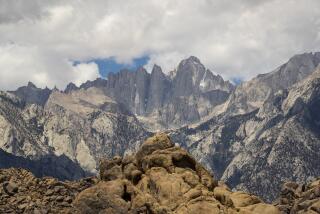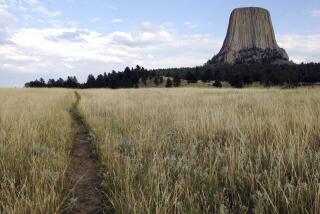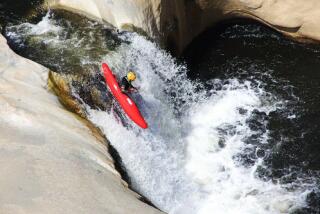For some climbers, Mt. Rainier’s often deadly allure is irresistible
Reporting from EATONVILLE, Wash. — Mt. Rainier looms over Puget Sound, seductive and deadly, wooing climbers and testing their skills.
Now, the icy peak has claimed six more victims in the second-worst mountaineering accident in Rainier’s history.
More than 14,000 feet high at its summit, the glacier-covered volcano rises alone above Seattle’s sludgy commutes, functioning as the ultimate harbinger of bad weather — “Is the mountain out?” is a common refrain — and beckoning the outdoorsy with its sheer proximity.
“There is a draw, but I can’t explain it,” said Len Throop, owner of Eatonville Outdoor, who has climbed Rainier many times but never crested the summit. “From the first time I ever saw it, I felt a connection. Even if you can’t see it, you know it’s there. And it’s dangerous. This week is one example, and it’s not even the worst.”
The worst accident came in June 1981, when 11 climbers died under giant chunks of ice.
Recovery efforts have been called off for the bodies of four climbers and two experienced mountain guides from Alpine Ascents International in Seattle. The six are believed to have fallen thousands of feet down a sheer, icy cliff to their deaths last week.
Authorities have not released their names, but Alpine Ascents confirmed that the lead guide was Matt Hegeman, a climbing expert who had scaled Rainier more than 50 times. A family member identified one of the climbers as Mark Mahaney, 26, of St. Paul, Minn., who dreamed of scaling Mt. Everest.
“All indications point towards a fall of 3,300 feet from near the parties’ last known location at 12,800 feet on Liberty Ridge,” a Mt. Rainier National Park spokeswoman said in a recorded message. “There is no viable chance of survival from such a fall.... At this point there are no plans to put people on the ground at the site because of the ongoing hazards.”
In coming “weeks and months,” she said, the climbers’ route will be checked occasionally from the air, and “potential opportunities for helicopter-based recovery will continue to be evaluated. There is no certainty that recovery is possible given these locations.”
Authorities debriefed relatives of Rainier’s latest victims Sunday, according to the father-in-law of one of the climbers. The man, who declined to give his name, said he had flown in from the East Coast on Friday night. His eyes were red and puffy as he grabbed a hasty lunch at Whittaker’s Motel & Historic Bunkhouse in Ashford, Wash., not far from the headquarters of Mt. Rainier National Park. He said he hadn’t eaten in two days. And he did not want to talk.
“We’re going to need all the prayers we can get to get through this,” he said.
Climbing Rainier is never easy, even via the least-challenging routes and under the best of circumstances, said Martinique Grigg, executive director of the Mountaineers, a Seattle nonprofit organization that teaches climbing skills and promotes outdoor activities.
“Only 50% of the people who try it, make it, any given year,” said Grigg, whose email and voicemail boxes have lit up since word of the disaster began to spread. “It’s a tough mountain. You need to be in good physical condition, and you need to have training to be safe in the mountains. You need to know how to travel over a glacier, how to rescue your climbing partners.”
Rainier has the largest system of glaciers in the United States outside of Alaska. The challenging terrain requires skill, stamina and equipment. Climbers must wear crampons, spiked implements that give their boots traction, and wield ice axes that help them arrest their slide down the mountain if they slip. They are often tied to their climbing mates for safety.
“It’s like being on a stair stepper at a steep angle for 10 hours, and that’s for just a normal route,” Grigg said. Liberty Ridge, the route the ill-fated climbers took last week, “is one of the most difficult on the mountain.”
Eric Linxweiler, a Mountaineers board member who has scaled Rainier several times, said climbers on the peak hear sounds like shotguns — rocks crashing down the fifth-tallest mountain in the continental United States. The eeriness is amplified by the time of day.
“We do almost all of our climbing in the middle of the night when everything is frozen,” Linxweiler said. “As the days get longer, every day the snow gets softer. As you’re walking uphill, you’re sliding. It’s much safer to be on the mountain when the mountain is frozen.
“Everyone leaves at midnight or 1 a.m. when they’re doing ascending work. You put a headlamp on and you go.”
Unlike Linxweiler and Grigg, who have not climbed Liberty Ridge, Mike Maude has made the taxing trek several times, reaching the summit twice, failing to summit two more times, helping to recover the bodies of dead climbers on three occasions and helping to rescue two climbers on a fourth.
“That ridge is steep enough and long enough that, once you get started falling, unless you can stop immediately, there’s no stopping,” Maude said.
Alpine Ascents runs 60 to 70 Rainier climbs each year, in addition to others around the world. The company canceled a Rainier climb that was scheduled to begin Sunday morning, and Monday’s Rainier ascent was in doubt, said Gary Harrington, the company’s director of operations.
Harrington said it was not possible at this point to know what caused the tragedy, which struck the small, close-knit climbing community hard. But he said the kind of problems include “rock fall, avalanche, a mixture of everything in between.”
The ground search for the six climbers’ bodies was called off because of the potential for danger to the recovery team.
“To continue searching there puts everybody at risk,” Grigg said. “The sad fact, sometimes bodies are not recovered. If they’re covered by avalanche debris, they could be covered 30 to 40 feet or more.”
But climbing experts said Sunday that, although last week’s accident could make people think twice about safety, it probably would not keep them off Mt. Rainier. The peak is just too alluring.
“We moved here six years ago,” Grigg said. “I would see that mountain and think, ‘I want to climb that one day.’ ... We talk about it as magical. You can’t see it sometimes, and then, all of a sudden, it’s just there on the landscape. That makes it compelling and curious. That’s what made it compelling to me.”
Times staff writer Matt Pearce in Los Angeles contributed to this report
More to Read
Sign up for Essential California
The most important California stories and recommendations in your inbox every morning.
You may occasionally receive promotional content from the Los Angeles Times.











